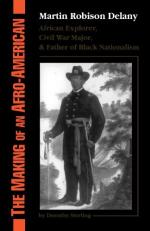|
This section contains 28,424 words (approx. 95 pages at 300 words per page) |

|
SOURCE: “The Redemption of His Race: Creating Pan‐African Community in Delany's Blake,” in Martin Delany, Frederick Douglass, and the Politics of Representative Identity, The University of North Carolina Press, 1997, pp. 177‐223.
In the following excerpt, Levine explores Blake as an expression of Delany's ideology, noting that the novel “can be viewed both as an allegorical account of Delany's quest for leadership in the community, circa 1852‐59, and as an engaged response to and intervention in events of 1859‐62. …”
Martin Delany's Blake; or, The Huts of America (1859‐62) may be read as an effort on his part, comparable with Douglass's in My Bondage and My Freedom, to define, fashion, and celebrate his representative identity as a Mosaic black leader. But how coherent is that self‐representation? The evidence suggests that the novel, first published in book form in 1970, emerged from multiple contexts and addressed Delany's sometimes competing interests and concerns.1 Eric J...
|
This section contains 28,424 words (approx. 95 pages at 300 words per page) |

|


